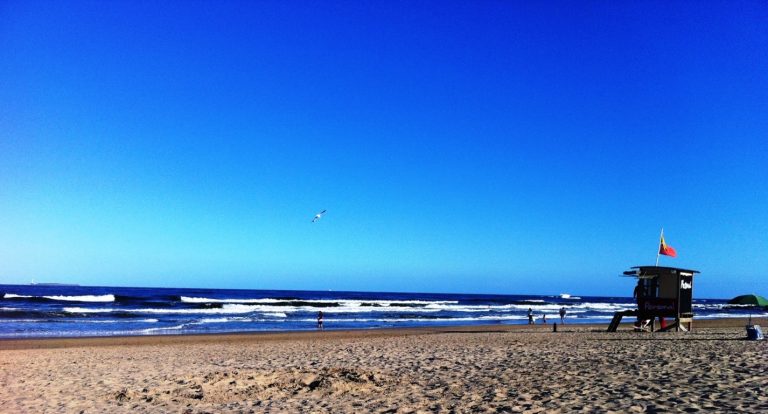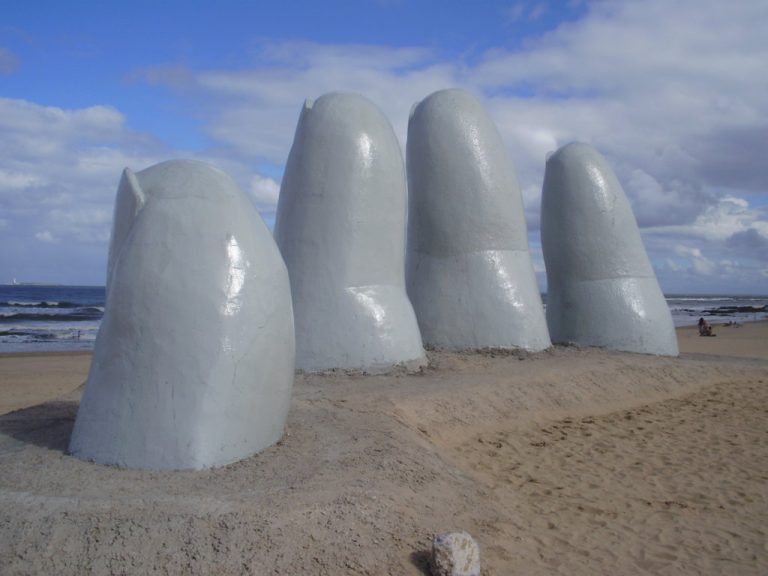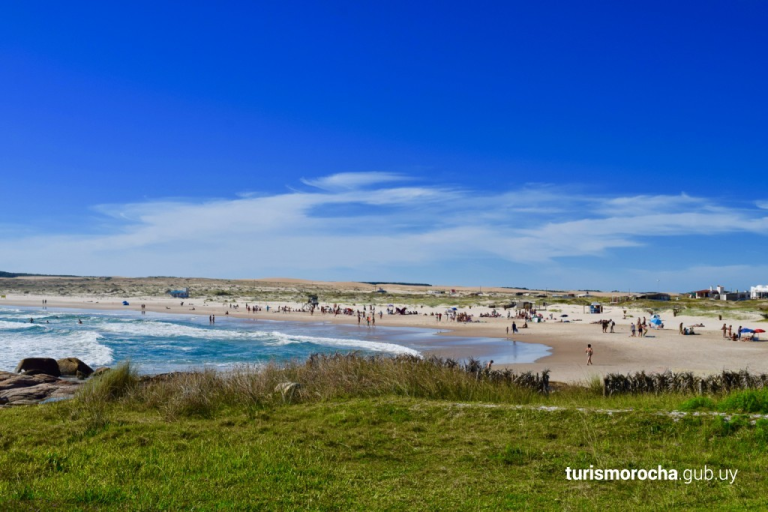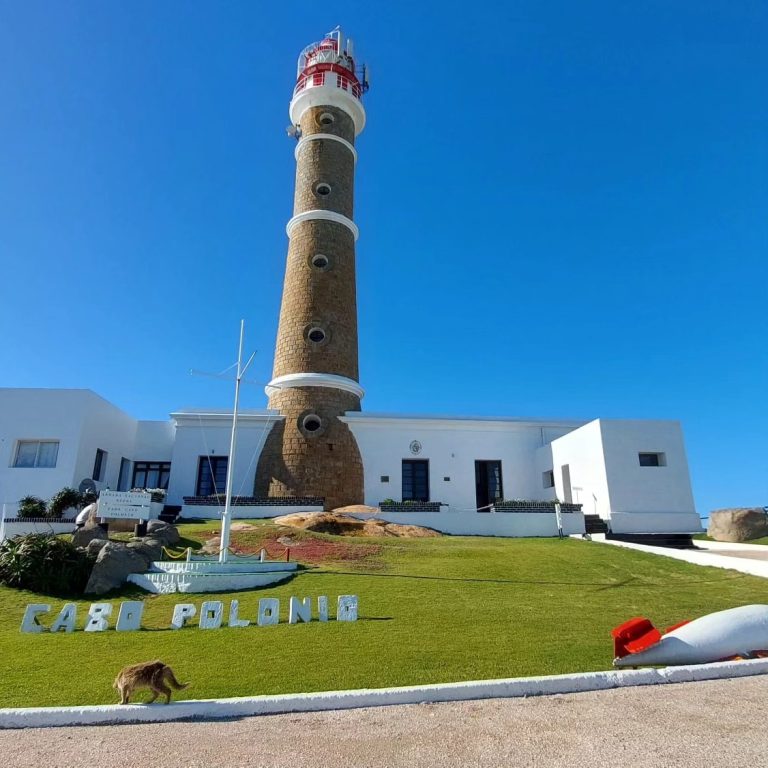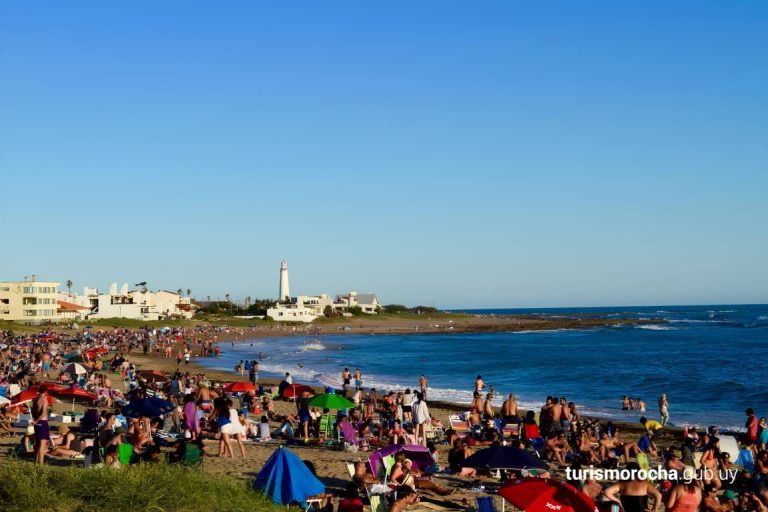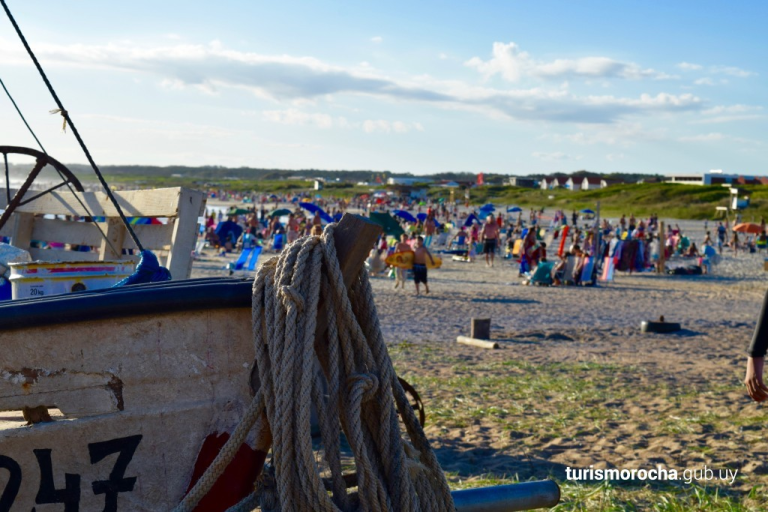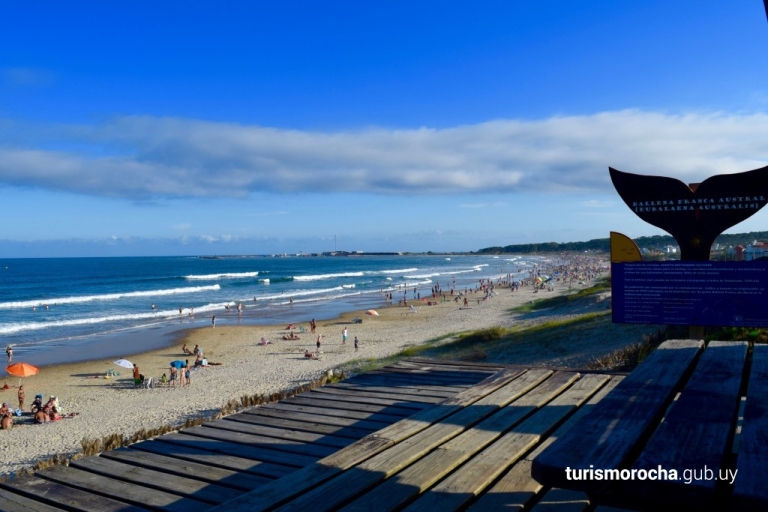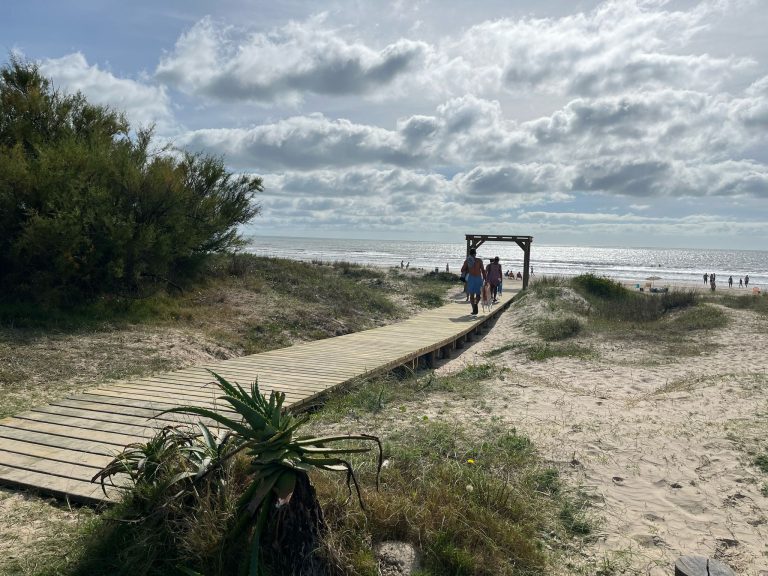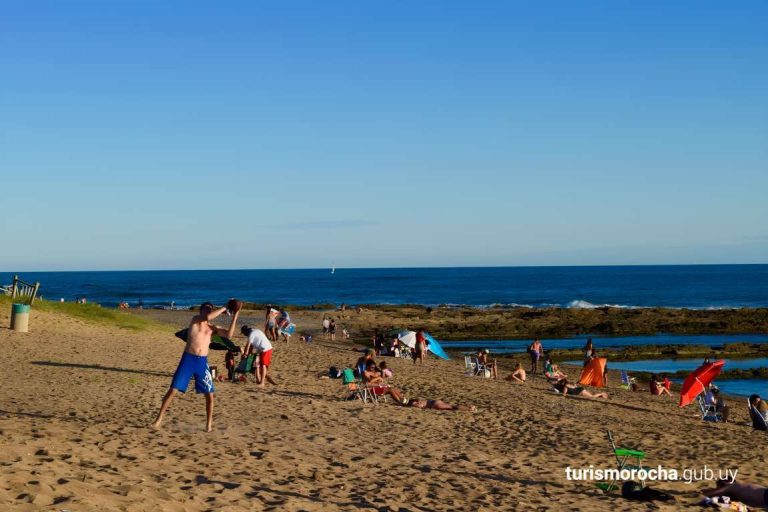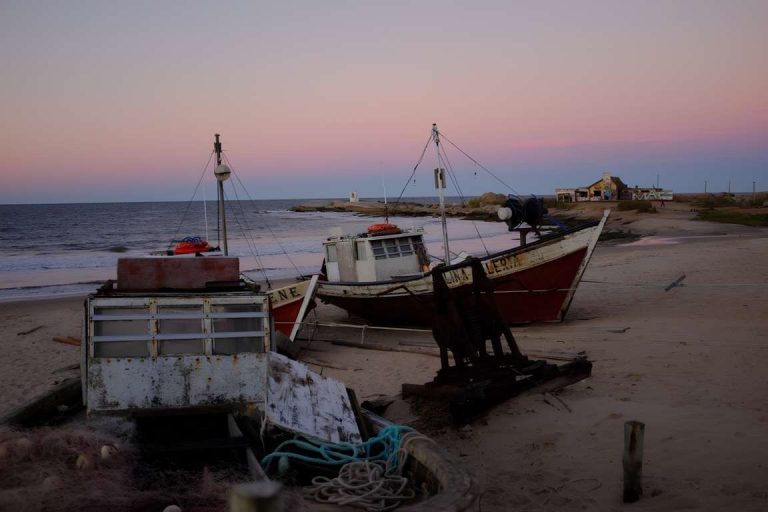When talking about Uruguay as a beach destination, it’s impossible not to think immediately of Punta del Este. This is the country’s most iconic seaside resort, often compared to Saint-Tropez or Miami for its glamorous lifestyle, manicured beaches, luxurious villas, and lively nightlife.
Set on a peninsula dividing the Atlantic Ocean from the Río de la Plata, Punta del Este has, over the years, become a symbol of sophistication, elegance, and international entertainment. A stroll along Avenida Gorlero, the city’s main thoroughfare, immerses visitors in a cosmopolitan and stylish atmosphere, dotted with art galleries, trendy cafés, nightclubs, and designer boutiques. Nightlife is a key part of the city’s identity: in the summer months, it comes alive with concerts, exhibitions, exclusive parties, and cultural events that attract not only the Uruguayan and Argentine elite, but also international celebrities.
Punta_Del_Este_Beach
La_mano_de_Punta_del_Este
Among its most iconic beaches, Playa Brava is famous for the sculpture La Mano—five giant fingers rising from the sand, now a symbol of the city—while Playa Mansa, facing the Río de la Plata, offers calmer waters and spectacular sunsets. Residential neighbourhoods like Beverly Hills and La Barra are home to dreamy villas nestled among maritime pines, and in the summer they host artists, politicians, businesspeople, and celebrities. Gastronomy is another highlight: Punta del Este boasts some of Uruguay’s finest restaurants, where traditional cuisine blends with global influences. Dishes featuring fresh seafood, grilled meats, and local wines create a culinary scene on par with the world’s greatest capitals.
However, there is another side of Uruguay—less glitzy, but more authentic. A different Uruguay reveals itself as soon as you leave Punta del Este behind and head east along the coast, following a ribbon of sand and sea that leads to places where time seems to stand still, where the energy is different, and where connection with nature feels deep and sincere. It’s a coastal route through some of the country’s most fascinating and lesser-known seaside towns. A journey that gives travellers the chance to discover Uruguay’s wild, bohemian soul.
One of the most iconic and surprising stops along this route is undoubtedly Cabo Polonio. To reach it, you must leave your car at the entrance of the national park, near the small village of Barra de Valizas, and board special off-road vehicles that cross miles of dunes, coastal forest, and sandy trails. Even this approach begins to set the tone—with the raw vibrations of the land and the deep silence of the surroundings, you already sense this place is something special. Once you arrive, Cabo Polonio reveals its striking simplicity: a handful of low houses resting directly on the sand, some brightly painted, others left in their natural state, as if they had simply emerged from the earth. The beaches are an essential part of the village’s soul. On the southern side of the promontory lies Playa Sur, a wide stretch of golden sand washed by strong waves—perfect for surfers, or for anyone who enjoys long, solitary walks. It’s the village’s most frequented beach, yet even in the peak summer months, it maintains an aura of tranquillity and raw freedom. People come here to breathe deeply, feel the wind, and contemplate the sea in complete harmony with the environment.
Playa sur Cabo polonio turismo rocha
Cabo polonio_faro
On the northern side of the cape lies Playa Norte—a more sheltered, intimate beach, often chosen by those seeking a quieter spot away from the elements. The sea here is slightly calmer, and the landscape is enriched by the sight of fishing boats, either anchored offshore or pulled up onto the sand. Around the lighthouse, which rises solitary on the headland like an ancient guardian, the coastline becomes rugged and dramatic, with crashing waves and rocky outcrops that serve as resting spots for one of the largest sea lion colonies in South America. Their presence adds a wild, almost mystical dimension to the area. Seeing them up close, shrouded in the salty mist, is a breathtaking and unforgettable experience.
For those craving adventure, there’s the option to venture further—along the path that connects Cabo Polonio to Valizas, traversing giant dunes, deserted beaches, and stretches of coastal vegetation. This journey, whether on foot or horseback, takes a few hours and offers surreal landscapes, profound silences, and the very real sensation of stepping into another time. Continuing eastward, you’ll encounter two beloved Uruguayan coastal gems that are still relatively untouched by international tourism: La Paloma and La Pedrera. Located not far from one another, they offer complementary experiences, perfect for travellers seeking a laid-back, authentic journey in tune with the natural surroundings.
La Paloma is a small seaside town with a simple, unpretentious spirit, ideal for a peaceful getaway with a variety of beaches, each with its own unique character. One of the most beloved is Playa La Balconada, close to the town centre and perfectly positioned to the west—making it the ideal spot to witness breathtaking sunsets that paint the sky and ocean in shades of rose and amber. In the evenings, this is the meeting point: for strolling, playing guitar, sipping mate, or simply watching the sun sink slowly below the horizon.
playa-la-balconada
Playa Los Botes_turismorocha
Further north is Playa Los Botes, a beach that still maintains its traditional fishing heritage. Here, it’s common to see fishermen pulling their boats ashore and mending their nets in the shade of coastal trees. The atmosphere is authentic and timeless, offering a glimpse into a slower, simpler life. For those seeking total seclusion, Playa El Cabito is a more hidden, intimate retreat, perfect for reading to the sound of the waves or indulging in an afternoon nap. Heading slightly east toward La Pedrera, two other beaches are worth a stop. La Aguada, wide and quiet, is ideal for families or travellers with pets, offering open spaces to roam freely. Even more evocative is Playa Anaconda—a windswept stretch of golden sand loved by surfers for its powerful, consistent waves. The sense of space and freedom here is magnetic, inviting long walks immersed in the scent of the sea and the sound of silence.
Just a few kilometres from La Paloma, nestled along a coast of pine forests and small headlands, you’ll find La Pedrera—a compact, alternative village with undeniable charm. Life here revolves around the main street that descends toward the ocean, lined with retro cafés, artisan workshops, vintage shops, and restaurants serving creative cuisine with stunning sea views. Unlike the more spread-out and family-friendly La Paloma, La Pedrera boasts a distinct bohemian identity. In the peak summer months, especially January and February, the village becomes a lively hub of artistic and youthful energy. Music drifts from the houses, bonfires light up the beach at night, and every corner seems to tell a story. Here, too, the ocean takes centre stage. The most iconic beach is Playa del Barco, named after the wreck of an old fishing boat lodged in the sand—now a local landmark. The beach is wild and free, with strong waves that attract experienced surfers, and vast space where you can bask in the sun without ever feeling crowded. Just to the north lies Playa Desplayado, with fine sand and calmer waters, perfect for families or anyone wanting to swim and unwind peacefully.
La Pedrera’s soul lies in the contrast between the raw force of the Atlantic and the gentle rhythm of village life. The experience becomes even more powerful when you walk the natural trail that connects La Paloma and La Pedrera, crossing grassy dunes, hidden coves, and scenic viewpoints overlooking the endless blue of the ocean. Many who stop in La Paloma or La Pedrera find themselves staying longer than planned. The blend of untouched nature, cultural depth, and simple living has a magnetic pull—a reminder that sometimes the most meaningful travels are the ones that invite you to slow down and simply be.
La Aguada
La aguada_Municipio de la paloma
Further north, not far from the Brazilian border, lies Punta del Diablo—a village that seems straight out of a storybook. Its sandy streets, brightly colored wooden cottages, fishing nets hanging from trees, and sun-faded murals tell a tale of simple life, shaped by the sea and the wind. Originally a humble fishing village, Punta del Diablo has grown over the years without losing its essence. Despite the increasing influx of tourists, especially during the summer months, it has retained a strong, authentic identity. The beaches of Punta del Diablo are an integral part of this experience. Right in the heart of the village is Playa de los Pescadores, the most iconic beach, where colorful boats rest on the sand and fishermen mend their nets at sunset. It’s a lively, lived-in beach, full of oceanic charm and daily life. It’s not unusual to see someone quietly fishing from the pier or groups of young people playing impromptu football matches on the damp sand.
Just a little farther along lies Playa del Rivero, a deep and scenic bay beloved by surfers and young travelers. Its consistent waves and sandy bottom make it ideal for water sports enthusiasts, but also for those who simply want to soak up the sun in a dynamic setting surrounded by untouched nature. In the late afternoon, this is where musicians, artisans, and solo wanderers gather—the beach transforms into a small natural amphitheater where people meet, play music, talk, and watch the sky turn gold. Venturing even farther north, you’ll come to Playa de la Viuda, wilder and quieter, often swept by strong winds and tall waves. It’s the perfect place for long walks, meditation, or solitary reading. Here, far from the more crowded spots, there’s a profound sense of connection with the ocean: all you hear is the sound of the waves, the calls of seabirds, and occasionally, the slow footsteps of a horse along the shore. Finally, heading south, you reach Playa Grande, marking the entrance to the Santa Teresa National Park, one of the most beautiful nature reserves in the country. This vast, often semi-deserted beach, even at the height of summer, is a true paradise for those who love walking immersed in nature. With golden sands, crystal-clear waters, and the park’s lush vegetation stretching toward the shoreline, every step brings a sense of freedom and discovery.
playa-el-cabito-turismorocha (1)
Playa de los Pescadores (1) (1)
Heading back west, just a few kilometers from Punta del Este, you’ll discover yet another side of Uruguay’s beach culture: José Ignacio. Once a humble fishing village, it has, over the past few decades, evolved into one of the country’s most exclusive destinations—but it has done so with discretion and refinement. Here, luxury is not ostentatious, but rather seamlessly integrated into the natural landscape. The houses are elegant yet harmonious, the restaurants serve exceptional cuisine in intimate and relaxed settings, and the boutiques offer unique, handcrafted pieces for those seeking something truly authentic. José Ignacio is a retreat for intellectuals, artists, writers, architects, and sophisticated travelers in search of beauty, tranquility, and authenticity. Its wide, uncrowded beaches are perfect for horseback rides or for simply watching the sunset with a glass of wine in hand. Every detail is carefully considered—never intrusive. It’s the ideal place for those who wish to slow down without sacrificing comfort.
Uruguay, in this sense, stands out for its ability to offer an authentic and diverse coastal experience, far from the excess and overcrowding of many other beach destinations. Here, protected areas, traditional villages, and well-established tourist spots coexist in balance, creating a unique harmony between nature, local culture, and modern amenities. The Uruguayan coast is defined by low urban density and a tourism approach that favors quality over quantity, with a strong emphasis on environmental sustainability. This makes the country especially attractive to travelers seeking direct contact with nature, open spaces, and a slower pace, without giving up a wide range of experiences—from surfing to nature exploration, from relaxation to cultural tourism.
Don’t miss news, updates, and cruise reviews on Cruising Journal, with photos, videos, and special cruise deals.

